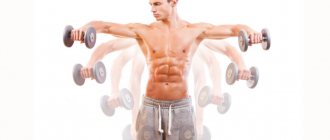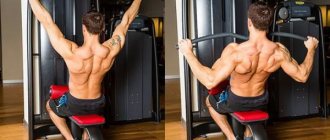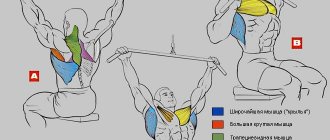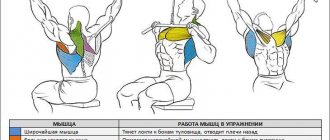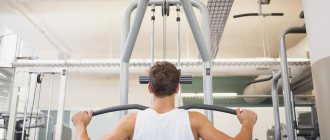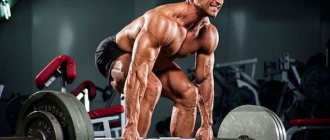Specifics of the exercise
The horizontal pull-down is a basic back exercise that targets the development of the latissimus dorsi muscles. To be fair, it should be placed in second place in the efficiency rating, right after universal pull-ups. But how many of you did pull-ups with ease in your first year of training? How many athletes can do 3-4 full sets of strict pull-ups?
For beginners, this is almost always an incomprehensible task. Therefore, horizontal, as well as vertical, traction should be the basis for the development of a powerful back. Otherwise, plans to quickly pump up will remain only at the level of desires and ideas.
I would like to pay special attention to the popular misconception that seated rowing is analogous to rowing. These are two separate exercises with different goals, so if you want to imitate the rowing motion of a cable machine, that would be a huge mistake. This way you won't get the lat load you need or the benefits of a rowing machine.
This exercise is worthy of becoming a staple for girls and women; it is ideal for rehabilitation and training at any age. The only recommendation I would like to give to beginners and even experienced athletes is not to use a belt. It is great for additional support of the lower back in standing exercises, but leads to unnecessary straining when performing movements while sitting. As a result, it provokes unwanted problems with the cardiovascular system.
What is good about horizontal block traction?
This exercise targets the latissimus dorsi, mid-trapezius, and spinal extensors even better. Variations in muscle activation levels during traditional latissimus dorsi weight training exercises: An experimental study, ACE-SPONSORED RESEARCH: What Is the Best Back Exercise? than the lat pull-down, an exercise that is often used to strengthen the back and prepare for pull-ups.
Abdominal pulls also target your hamstrings, elbow flexors, and strengthen your spinal erectors—muscles that are critical to your back health and ability to lift heavy weights in exercises like deadlifts and squats.
In addition, this movement is as simple and comfortable as possible, does not require long mastery and is suitable even for absolute beginners.
What muscles work
In order for the exercise to bring maximum benefit, you need to clearly understand which muscles receive the main load. Without this, it is impossible to create a competent and balanced training program. The main muscles worked in the deadlift:
- Latissimus.
- Trapezoidal.
- Large diamond-shaped.
- Spinal extensors.
Additional load goes to the triceps, biceps, rear deltoids and chest. If the correct technique is observed, the main load will go to the latissimus muscles, the remaining groups work in a passive mode. When I see gym goers who, with all their might, pull the handle towards their waist with their hands, additionally helping themselves with their legs, I understand that without theory, practice is almost useless. Remember, the handle is not pulled by the biceps, but by the lats. Focus on the muscle, feel how it works, and then the pull will be effective.
The benefits and harms of exercise
The benefits of exercise are simply undeniable. This movement allows you to train your lats with heavy weights without harm or consequences. And most importantly - without axial load on the spine and other negative factors. Also, when doing this, a minimal load is placed on the lower back, so I recommend this exercise both for teenagers and when recovering from childbirth (but only with minimal weights, without straining and with the permission of a doctor).
To summarize, the main benefits of horizontal traction are:
- Safe work with heavy weights (which means increased production of anabolic hormones).
- Minimal risk of injury compared to other exercises.
- Improved posture.
I would not talk about the dangers of the exercise, especially considering that working with the lower block is considered the safest. In fact, this is an analogue of a bent-over barbell row, which allows you to fix the position and better control the position of the body.
However, there are two main disadvantages that can greatly reduce its effectiveness:
- Strong body swaying.
- Pull using the strength of your arms and shoulders, not your back.
Both disadvantages are caused by incorrect execution technique and incorrectly selected weight in the simulator.
The meaning of the exercise and muscle work
Horizontal rows in a pulley machine are one of the required exercises on the day when you train your back. By varying your grips, you can work your lats from all angles. This is very convenient when, with the help of basic exercises, you have already built up mass and want to give the muscles the desired shape.
During the exercise the following works:
- The latissimus muscles bear the main load.
- Biceps - Helps you pull weights by bending your elbows.
- Spinal extensor muscles. They are responsible for straightening the back.
- Additionally, the trapezius muscles, teres major, rhomboids, and rear deltoids are included.
If you do the exercise incorrectly, the biceps or lower back will work, and the lats will tighten last.
Therefore, pay special attention to technology
Seated pulley rows, also known as rowing rows, are performed using a special pulley machine. Usually the simulator has a lower and an upper block. The top one can be pulled behind the head or to the chest, and we will pull the bottom one to the belt.
Don’t be confused, rowing a barbell to the waist and rowing a horizontal block are two different things. The first exercise is basic mass-gaining. The second is more formative, it is done while sitting.
So, let's start doing the exercise:
- Set the desired weight (for men – 10 kg, for women – 5). Now we will do a warm-up with light weights.
- We rest our feet on special supports, bend them at the knees, and find a comfortable position (the angle can be from small to 90 degrees). Keep your back straight, with a natural arch in your lower back.
- We stretch our arms forward and clasp the pre-installed handle.
- We pull the weight towards ourselves until the body reaches a position perpendicular to the floor. From this point we begin to do repetitions.
- Straighten your shoulders, bringing your shoulder blades together, pull the handle towards your stomach. You should feel the load in your back, not your biceps. We will return to this later.
- When the handle touches your waist, hold this position for 1 second. In this position, your shoulder blades are retracted as much as possible.
- Then release the weight back. In the classical technique, the body remains motionless. If you perform the exercise by tilting your body forward following the weight, then you should not bend over too much and round your back. Even if the tiles of the machine have not completely lowered. During the entire exercise, the deflection in the lower back is maintained, and the shoulder blades remain pressed. The difference between the two techniques is described below.
When, during an exercise, you lean your body forward while lowering the weight, and then lean it back again during the next lift, you also force the back extensors to contract. These are long muscles that run along the spine. The latissimus muscles (namely, the exercise was originally intended for their development) are responsible for bringing the arms to the body. That is, the lats work precisely when you pull your elbows back.
Therefore, if your goal is the lats, fix your body in one position and work exclusively with your hands, without leaning forward with the weight. If you want to work your entire back, bending forward will help you stretch your muscles better before your next rep. But remember that in this case there will be a risk of injuring your lower back.
Do 10-12 reps in 3-4 sets with the working weight.
Correct technique and types of exercises
In bodybuilding, maintaining the correct technique is an axiom and a paramount rule (which is often violated, most often out of ignorance). Therefore, the better you comply with all the technical features, the greater the effect will be from performing each repetition in the approach. Now I will talk about the main types of deadlifts and their differences.
To the belly
This is a basic version of front traction, which is considered completely universal. I would like to note that performing the movement in a low crossover block is not considered a replacement. With this technique, the cable will not move horizontally, but from bottom to top. As a result, the load angle changes and other muscles will be involved in the work. If you sit on the floor and not on a bench, then doing the exercise will be uncomfortable. This option is suitable only if there is no special simulator (although I have not met a gym where it was not installed).
Performing a deadlift looks like this:
- Sit on a bench and rest your feet on the platforms so that your knees are slightly bent.
- Grab the short handle with a neutral, close grip (depending on the handle).
- Level your body and move it forward a little.
- Begin to slowly move the handle towards your stomach, slightly tilting your body back.
- At the peak point, squeeze your shoulder blades together as much as possible, then return the handle to the starting position.
I would like to emphasize that body sway should be minimal. Just to better stretch the lats.
To the chest
Performing rows to the chest allows you to shift the load from the lower part of the trapezius to the upper part, as well as to the shoulders. The latissimus muscles also receive the main load, but you need to pay attention to the deltoids so that they do not become overextended. If they are the weak link in the deadlift, you will not be able to lift heavy weights and will reduce the effectiveness of the exercise. A narrow handle is best, but if you have good shoulder mobility, you can do the exercise with a medium grip. In any case, a wide grip is not recommended due to the strong reduction in amplitude and increased load on the shoulders.
To the head
Bringing the handle to the face is more classified as shoulder movements, because the main load is significantly shifted to this muscle group. However, this row works well on the upper lats and rear deltoids. I recommend doing this option for those who have problems with posture. In this case, the ideal scheme would be to alternate classic rows in a sitting position and bringing the handle to the face (to the chin, to be more precise).
Pulldown to the stomach from the lower block on the bench
Muscles involved: shoulder girdle, lower back
Main indications: Pain in the cervical spine, headaches, herniated discs in the cervical spine
We recommend reading: How to set the time on the Xiaomi Mi Band 2 fitness bracelet: set and change the clock and date without a smartphone and application, set the correct time zone and select display
Technique: sitting on a bench, feet shoulder-width apart, holding the handle of the exercise machine in your hands. We perform rows to the lower abdomen. In the first phase, the lumbar region and elbows, and shoulder blades together, first bend. Second phase – pull the handle to the lower abdomen (exhale)
Repetitions: 10 - 12 reps
Important! The legs rest on the floor, the arms stretch, the back extends to 45 degrees relative to the bench. There is no need to be afraid to exercise through pain.
Example of a workout with the addition of horizontal rows
What is the proper training for seated deadlifts? To begin with, a complete warm-up of the whole body, even the legs. After this, it is better to switch to pull-ups or a vertical block as a replacement. Only then should you start deadlifting, when the muscles are sufficiently warmed up and you can push yourself to the maximum in heavy strength approaches. The entire back workout after warm-up and cardio will look like this:
- Pull-ups/vertical pull-downs with wide handles.
- Horizontal block traction.
- Bent-over barbell/dumbbell rows.
- Shrugs with dumbbells.
- Hyperextension.
If a deadlift is added, then it should be placed in the middle of the workout, and also perform 2 sets of hyperextension to warm up the lower back.
At home
Even without going to the gym, horizontal rowing is available to everyone. How to replace a bulky exercise machine? The answer is simple - rubber bands. Just secure them at the desired height and perform deadlifts just like you would in the gym. The movement can be performed with one hand for greater clarity and focus on the back.
Example workout:
- Warm up.
- Pull-ups on the horizontal bar.
- Horizontal pull of the rubber band.
- Shrugs with dumbbells.
The harness exercise can be alternated with bent-over dumbbell rows for weeks at a time.
In the gym
Perform deadlifts as usual, after 1-2 back exercises and a full warm-up. Choose the repetition mode depending on your training goals, but I do not recommend going beyond 3-5 sets.
Example of a gym workout:
- Weighted pull-ups/vertical rows.
- Lever row in the machine/dumbbell row in an incline position.
- Horizontal row in a block machine.
- Shrugs.
- Hyperextension.
What is horizontal block thrust
The horizontal pull-down is a strength exercise for developing the back muscles, which is performed on a pulley machine.
It is also called the lat pull-down and simply the abdominal pull-down. The Lifehacker Telegram channel contains only the best texts about technology, relationships, sports, cinema and much more. Subscribe!
Our Pinterest contains only the best texts about relationships, sports, cinema, health and much more. Subscribe!
Horizontal block thrust. Photo: Yulia Obolenskaya
To perform it, a V-shaped or wide handle is attached to the lower block, a person sits on a bench, puts his feet on special supports and, bending his elbows, pulls the handle to his stomach.
Training Tips
Warm-up
Without a good warm-up, it’s better to get dressed and go home, because every movement can be traumatic. Stretch not only your back muscles, but also your entire upper body. A 4-5 minute warm-up and 5-10 minutes of light cardio at the beginning of the workout is enough.
Sets and reps
For beginner athletes, it is better to work in a repetition regime of 8 to 10.
For men, it's best to work in the 6-8 rep range to build strength and muscle mass. For girls, high-repetition work of 12-15 repetitions is ideal, but with a reduction to 8 in the last approaches and a gradual increase in weight.
The optimal number of approaches for deadlifts is from 3 to 5.
How to choose a working weight
You can only choose the right weight experimentally. Start small and try to get to a weight where you find it difficult to complete 5-6 reps. Based on this in subsequent workouts, but remember the progression of the load.
What grip to use
Regarding the position of the hand, it doesn’t matter. The lats will receive the same load in any case. Medium and wide grips are great for rowing, so you can better pull your shoulders back and retract your shoulder blades.
Nutrition and sports supplements
All these beautiful photos and videos of professional athletes who deadlift and get extraordinary relief are advertising fiction. Horizontal traction is needed for powerful power work. If you want to become slim, then you need to control your nutrition and diet. Exercise is nothing more than a mechanical element that forces the body to respond to stress. Of the mandatory sports supplements, I can only recommend protein and vitamin-mineral complexes. I advise men to add creatine to the list to increase strength and progression.
Common mistakes
The deadlift is an exercise with a minimal arsenal of mistakes, but gym goers try their best to use them. Here are the main ones:
- Excessive body sway.
- Lack of focus on the target muscle (latissimus).
- Incomplete retraction of the shoulder blades at the peak point.
- Rounding the back.
Each mistake significantly reduces the effectiveness of the exercise and can cause injury.
Block pull in the simulator
The seated row of a block to the waist engages almost all the muscles of the upper body - the latissimus dorsi as the main muscles, as well as the muscles of the arms (forearms, biceps and triceps), shoulder girdle and lower back. In addition, the muscles of the legs and abdomen are indirectly involved.
The exercise is important in training the back, giving it visual width. The pull-down row is a variation of the basic barbell row exercise, essentially repeating the movement but with a different angle of application of force due to the seated position.
Execution technique
Starting position
: sitting in the simulator, legs placed on the front platform, knees slightly bent, but not fixed. Reach forward to grasp the handle of the pulley, while maintaining the natural roundness of your back and without trying to straighten up as much as possible.
Pull the weight towards you with straight arms. Stop at a point where the angle between your torso and legs is approximately 90 degrees; then, pushing your chest forward, bend your back slightly in the lumbar region. You should feel tension in the latissimus dorsi muscles.
Mechanics of movement
Keeping the position of your torso as motionless as possible and trying not to lean back, while inhaling, slowly pull the handle towards your belt until it touches your stomach. As you move, straighten your back, pushing your shoulders back and pushing your chest forward.
As you make the movement, arch your lower back and bring your shoulder blades together until you feel a fairly strong “compression” of the muscles of your upper back. Stay in this position for a few seconds, and then slowly, as you exhale, return to the starting position.
Preparing for the exercise
When preparing the machine for training, be sure to adjust it to your height: the height of the seat should be such that the cable of the pulley remains parallel to the floor when performing deadlifts, and the feet should have support to prevent the body from sliding forward.
The classic pull-down of a block to the belt is performed with a V-shaped handle (palms facing each other, see illustration). The use of wider handles or handles from a machine for upper rows is permissible only after full mastery of the technique.
The main secret of technology
The correct technique for performing block pulls to the belt involves two stages of pulling the weight towards you. The initial stage ends when the arms are bent when the elbow reaches the torso. The second stage begins with further movement and the elbow moving further than the back.
The working muscles of each stage are different - in the first stage the arms are involved, while the back itself works in the second
It is important to note that moving your shoulders back and pushing your chest forward should occur just as you transition between stages.
Runtime errors
In most cases, incorrect execution of the block row to the belt leads to the fact that the arm muscles are involved in the work rather than the back muscles. Trainees use too much weight and try to pull it towards themselves by arching their whole body.
Remember that when performing the exercise correctly, it is important to keep your elbows as close to your body as possible and not spread them to the sides. In addition, maintain a vertical body position and do not lean back more than 10-15 degrees
Should you round your back?
Sometimes you can hear the opinion that at the starting point of the movement it is necessary to round your back quite strongly in order to “stretch” the latissimus muscles and increase their involvement in the work - this is exactly the technique that Arnold Schwarzenegger advised.
However, it is important to note that rounding your back significantly increases your risk of injury because it places dangerous stress on your spine. FitSeven strongly discourages the use of this technique by non-professional athletes
The belt row is an important exercise for working the back muscles. Correct technique involves keeping your elbows close to your body and minimally deflecting your body from the vertical. The most common mistake: working with the muscles of the arms, not the back.
Conclusion
Cable horizontal rows are a great exercise. It can be replaced with dumbbell rows or barbell rows, but you are unlikely to be able to work with the same weights and efficiency. The exercise is truly universal, effective and safe, so I strongly recommend including it in the training program for anyone who wants to have a developed back and good posture.
If this article was useful to you and you were able to take a completely different look at an exercise that you had previously done or excluded from your program, then it’s time to subscribe and share the article on social networks. I promise, there is still a lot of useful material ahead of you that will help you understand how to train correctly and how the fitness industry is filled with misconceptions and myths.
